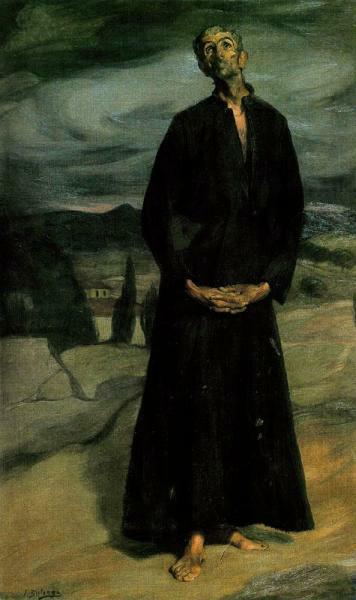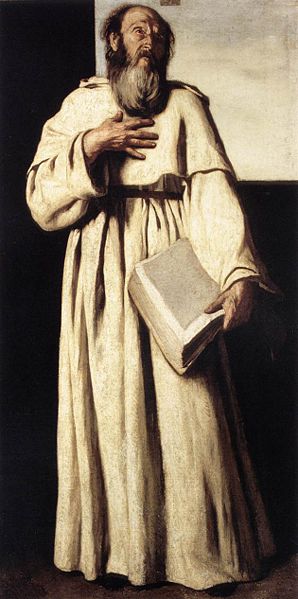Here are two anchorites – hermits, that is, of painters in Spain and Italy.
“The Anchorite” of Zuloaga (left) seems entirely 17th century El Greco, with the elongated human figure, and the whirlwind of sky and dwarfed town like the latter’s famous “View of Toledo.” But the artist is Ignacio Zuloaga, who painted it in 1907.
The landscape here has become an odd counterpart to the desert, to the world as desert, and though his vestment is conventional, the hermit’s expression is not. The unshaven, barefoot hermit has not a pious but disengaged expression on his face, wistful or mad, the input of centuries of Spanish art, peaking around Goya. The anchorite is not approachable, for he is no longer of this world.
Curiously, Aniello Falcone’s “The Anchorite” dates from that period which Zuloaga studied: 1650. But Falcone’s anchorite lacks Zuloaga’s psychological depth, its urgency. Few hermits existed in Zulouga’s modern times, so the inspiration from an old master is helpful but not conclusive in the hermits’s expression. Falcone’s model hermit, too, must conjure an old master, for true hermits were few even in his day, but the psychology is different. Falcone’s hermit, while posing a mystic air, betrays his cloistered status with his warm clothing and the large Bible he carries. He stands in a passageway of his cloister, not in the harsh terrain of life without. Falcone’s hermit is a student of ideas not yet his own, looking not to heaven but elsewhere, abstractly. Zuloaga’s hermit is in the world, and though his clothing is not ragged, we can anticipate that it will be soon.
But let us not judge too harshly or choose sides. Their paths are slightly different, but only based on what they are capable of. They are hermits nevertheless, and that is what attracts us to them.
Falcone’s “The Anchorite” is in the Galleria Nazionale d’Arte Antica, Rome. Zuloaga’s “The Anchorite” is in the Musee d’Orsay, Paris.
 |
 |
